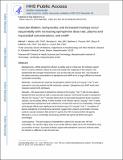Vascular Dilation, Tachycardia, and Increased Inotropy Occur Sequentially with Increasing Epinephrine Dose Rate, Plasma and Myocardial Concentrations, and cAMP
Author(s)
Maslov, Mikhail Y.; Wei, Abraham E.; Pezone, Matthew J.; Lovich, Mark A.; Edelman, Elazer R
DownloadEdelman_Vascular dilation.pdf (1.003Mb)
PUBLISHER_CC
Publisher with Creative Commons License
Creative Commons Attribution
Terms of use
Metadata
Show full item recordAbstract
Background
While epinephrine infusion is widely used in critical care for inotropic support, there is no direct method to detect the onset and measure the magnitude of this response. We hypothesised that surrogate measurements, such as heart rate and vascular tone, may indicate if the plasma and tissue concentrations of epinephrine and cAMP are in a range sufficient to increase myocardial contractility.
Methods
Cardiovascular responses to epinephrine infusion (0.05-0.5 mcg kg⁻¹ min⁻¹) were measured in rats using arterial and left ventricular catheters. Epinephrine and cAMP levels were measured using ELISA techniques.
Results
The lowest dose of epinephrine infusion (0.05 mcg kg⁻¹ min⁻¹) did not raise plasma epinephrine levels and did not lead to cardiovascular response. Incremental increase in epinephrine infusion (0.1 mcg kg⁻¹ min⁻¹) elevated plasma but not myocardial epinephrine levels, providing vascular, but not cardiac effects. Further increase in the infusion rate (0.2 mcg kg⁻¹ min⁻¹) raised myocardial tissue epinephrine levels sufficient to increase heart rate but not contractility. Inotropic and lusitropic effects were significant at the infusion rate of 0.3 mcg kg⁻¹ min⁻¹. Correlation of plasma epinephrine to haemodynamic parameters suggest that as plasma concentration increases, systemic vascular resistance falls (EC50=47 pg/ml), then HR increases (ED50=168 pg/ml), followed by a rise in contractility and lusitropy (ED50=346 pg/ml and ED50=324 pg/ml accordingly).
Conclusions
The dose response of epinephrine is distinct for vascular tone, HR and contractility. The need for higher doses to see cardiac effects is likely due to the threshold for drug accumulation in tissue. Successful inotropic support with epinephrine cannot be achieved unless the infusion is sufficient to raise the heart rate.
Date issued
2015-02Department
Harvard University--MIT Division of Health Sciences and TechnologyJournal
Heart, Lung and Circulation
Publisher
Elsevier
Citation
Maslov, Mikhail Y. et al. "Vascular Dilation, Tachycardia, and Increased Inotropy Occur Sequentially with Increasing Epinephrine Dose Rate, Plasma and Myocardial Concentrations, and cAMP." Heart, Lung and Circulation 24, 9 (September 2015): 912-918 © 2015 Australian and New Zealand Society of Cardiac and Thoracic Surgeons (ANZSCTS) and the Cardiac Society of Australia and New Zealand (CSANZ)
Version: Author's final manuscript
ISSN
1443-9506